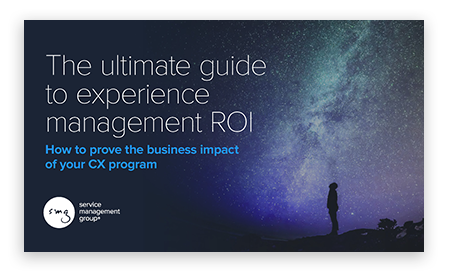Making the Business Case for Investing in CX
Published on Dec 14, 2022

Companies don’t just invest in customer experience (CX) programs because they want happy customers. That’s an added benefit, but organizations also know higher customer satisfaction is the most direct path to profitable growth. While seeing improvement strategies bump up scores and chip away at competitors’ visit share is great, at a certain point, financial gains need to show up on the bottom line.
Financial linkage—through demonstration of how better experiences lead to better sales—is the best way to secure and sustain stakeholder buy-in of your CX program. Without it, you’ll be hard-pressed to advance your efforts or receive future investments. But when you are able to connect the dots between CX metrics and broader business goals, it’s much easier to get your executives on board.
In this blog, we’ll help CX practitioners making the business case for investing in CX by sharing 3 key metrics to focus on, along with 3 examples of brands leveraging those metrics to prove financial impact.

How to prove the business impact of your CX program
CX metric to measure #1: Average ticket amount
No matter how big your business grows, it lives and breathes at the location level—which is why it’s important to understand how CX scores relate to (and impact) each location’s sales.
Transaction-level analyses are the most detailed sources of financial linkage because they cut straight to the chase and answer: Does a better customer experience actually lead to better sales? You know better experiences do drive business results, but transaction analyses also go a step further by allowing you to investigate the financial impact of things like ongoing promotions, front-line service standards, key performance indicators, and problem resolution processes. That’s the difference between demonstrating the scores sales linkage and putting processes in place to improve it.
While there are several location-level analyses you can run, one of the most beneficial is a deep dive into average ticket amounts. This information can provide valuable data such as:
- A comparison of the level of satisfaction to an incremental increase in spend (e.g., Highly Satisfied customers spend an average of 16% more than Satisfied customers)
- The impact of product recommendation (e.g., customers spend 20% more on average when associates recommend an item)
Not only will your leadership team be impressed to see these revenue-generating opportunities, they’re also incredibly helpful in motivating your field teams and driving actionable change. Let’s take a look at how one brand saw business growth by doing just that:
Success story #1: Retail brand focuses on assistance availability and increases average ticket sales
One specialty retailer wanted to be proactive leading into the holiday season and find a way to increase engagement with their shoppers and increase customer loyalty, even during their busiest times of year when customers tend to receive less assistance.
The brand turned to its CX data and concluded Overall Satisfaction scores decreased during the holiday season, a common theme for retailers. On top of that, customers who didn’t interact with an associate were not only spending considerably less, but their Overall Satisfaction was significantly lower when they left the store without interacting with an associate.
The brand took action on this key factor by:
- Implementing a customer engagement ambassador during the holiday season
- Monetizing the financial impact of the new role
- Reintroducing the ambassador during the summer promotion season
Not only did those efforts pay off with improved Availability of Assistance scores, but the average ticket amount increased 2x when customers were highly satisfied with the assistance they received.
CX metric to measure #2: Problem resolution improvements
In today’s competitive climate, brands that aren’t prioritizing case management and their close-the-loop resources will likely be left with unhappy ex-customers who have taken their business elsewhere. What those brands don’t know is opportunities to win customer loyalty are cleverly disguised as problems.
The fact is, you can learn a lot from a happy customer—but you might learn just as much from an unhappy one and get a boost if you can stick the landing. SMG research shows 65% of customers who report problems are less than highly satisfied with the way their problems are resolved. But of those customers who are highly satisfied with their problem resolution, 84% express a high likelihood to return to the business where the problem occurred.
Ready for something even more interesting? Customers who had a problem but were highly satisfied with how that problem was handled are actually more likely to return to a business than customers who had no problem at all. How’s that for the impact of a closed-loop feedback program!
Here’s how one brand was able to reduce customer churn and detractors through customer recovery solutions:
Success story #2: Empowering staff to resolve customer issues leads to higher sales for QSR brand
This restaurant brand turned to its CX data to see how employees were handling customer issues and faring with their close-the-loop process.
To guide its focus, its SMG team conducted an analysis on problem resolution and discovered more than half of guests had to repeat their issues to managers, causing a 30-ppt drop in problem resolution and a 26-ppt drop in Overall Satisfaction.
Though the brand previously thought it was best practice to engage a manager when problems occurred, data showed guests actually prefer front-line employees take immediate action on their own.
With this new information, the brand presented the data to franchisees to prove problem resolution should be handled by front-line employees. And to drum up engagement, they launched a branded service recovery initiative that empowered staff members to attempt to resolve customer issues on their own.
The new initiative worked, with a 6-ppt increase in Problem Resolution and a 2-ppt uptick in Overall Satisfaction. The brand also saw a decrease in customer complaints and higher comp sales.
CX metric to measure #3: Cost savings analysis
Whether you’re launching a promotion involving limited time offers (LTOs) or one-time offers, implementing a new POS system, or making updates to your labor model, any major change to your business should be analyzed to ensure it’s having a positive impact on your customers and is actually cost-saving. You could be losing money on that LTO, or the new POS system could be slowing down service. And maybe you’re seeing cost reductions with a slimmed down front line, but what if that’s resulting in lower comp sales?
Demonstrating the quantifiable impact of any business investment on the customer experience is a great way to determine its value. Let’s look at how one QSR brand tested this out and made the right moves to drive operational efficiencies:
QSR brand celebrates the no-go decisions that drive positive impact
One QSR brand decided to run a test at pilot locations before committing to a full rollout of new digital menu boards. To measure the impact on the customer experience, they implemented three different digital menu board prototypes across separate locations and worked with their SMG team to periodically compare results against locations still using traditional menus.
Their strategic plan led to the discovery that CX scores stayed flat across the test locations. The team then went a step further by layering in financial datasets to measure the bottom-line impact, only to find there was no uplift in sales.
While this valuable feedback make it clear the digital menu boards didn’t offer enough ROI for a full rollout, the brand needed to be methodical about how they communicated the no-go decision to stakeholders. They created a video of members of the executive team breaking down the data-fueled analysis that led to the decision, delivering a strong business case to stakeholders they’d done their homework and the new technology wouldn’t be worth the operational costs.
Don’t settle for a feedback program—invest in a customer insights program
They may sound similar, but they’re worlds apart. A feedback program essentially amounts to a list of customer reviews. There may be some interesting tidbits here and there, but for the most part, it’s something that just sits on your shelf collecting data.
A customer insights program, on the other hand, tells you what the data is actually saying in more direct ways that lead to meaningful actions and tangible results on your program’s ROI. When you can go beyond a platform provider with bare-bones products and find a program partner with professional services that’s passionate about the customer experience and dedicated to getting to know your business, it makes it that much easier to tailor the program to organizational initiatives—and vice versa. When that happens, you’ll notice there are fewer nice-to-know reports—and a lot more need-to-know.
For more information on securing and sustaining investment in your CX program, check out the ebook: The Ultimate Guide to Experience Management ROI.
Related articles

Customer Experience (CX) Buyer Checklist—9 key considerations for evaluating a CX provider
These are the 9 key aspects to consider when evaluating CX providers to find a partner that understands your industry and customers to help drive program ROI.

The economic impact of a customer experience management program on your business: How to potentially develop 550% ROI in 3 years or less
An experience management (XM) program can drive changes across your business that increase loyalty, reduce churn, and generate revenue—and even the

Does your customer experience management software give you insights… or homework?
Turning data into actual insights is a hurdle many in the customer experience game are trying to clear. Your customer experience (CX) software might provide you with a large amount of customer data, b